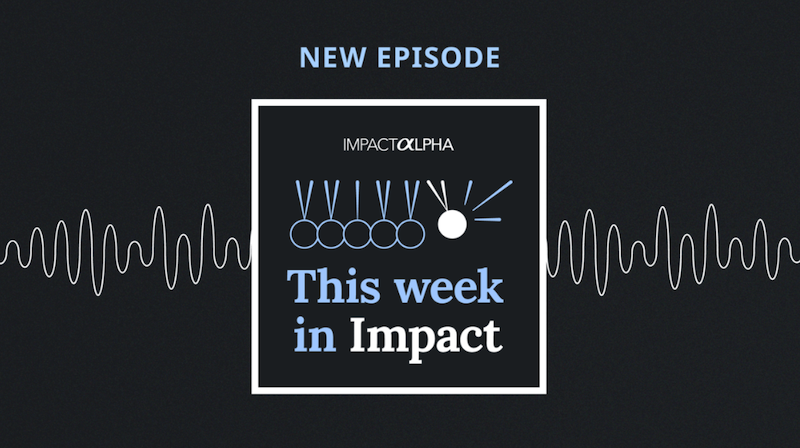It is hard to miss the incredible growth and attention that impact investments have achieved in recent years. With a near constant stream of high-profile individuals and firms making impact investments, the industry is featured in the pages of newspapers and financial magazines on a daily basis.
But one of the industry’s most impressive areas of progress and achievement rarely makes headlines, even though it is fundamental to impact investing — impact measurement and management.
Through this practice, impact investors are pioneering strategies to measure the social and environmental performance of their investments. They use this data to better understand the impact (both realized and potential) that they generate for people and the planet, manage their investments for greater impact, and help their investees make better-informed business decisions.
In short, the increasingly sophisticated practice of impact measurement and management is enabling impact investors to manage their impact performance with the same data-driven approach they apply to financial performance.
Why measure impact? Because of its business value.
State of play
To better understand the impact measurement and management (IMM) approaches of impact investors, for the first time ever we have a comprehensive data set on current practice. The Global Impact Investing Network’s new report, The State of Impact Measurement and Management Practice, provides data from 169 investors on their motivations, strategies, and perceptions of impact measurement and management, serving as an invaluable resource for impact investors to understand how their IMM practice compares to other organizations’ and the direction in which the industry is moving.
https://medium.com/media/6f83d56e2c07e5b7faf63a9394a53fc8/href
The data surfaces areas where investors can challenge themselves to advance their IMM approaches. Based on the findings, the GIIN encourages all impact investors to explore the following opportunities to strengthen their practice and further deepen their impact:
1. Investors should recognize that every investment creates multifaceted impact. Currently, two out of three impact investors measure only the positive impact of their investments. By monitoring negative externalities as well, investors can obtain a broader understanding of the complete impact of their activities.
Investors can then use this information to explore ways to better understand and address the needs of the various stakeholders affected by their investments — such as investee clients, employees, suppliers, and the environment.
2. Impact investors can enhance the rigor of their impact strategies by setting targets and embedding them into business practices (just as it is standard to set financial performance targets). Currently, some 60% of impact investors set targets for the impact they seek to achieve.
Having specific goals can help inform clear data collection efforts, drive performance management, and ensure accountability. Investors can then motivate their staff and investees to meet such targets using similar incentives to those used to encourage strong financial performance. For example, some investors tie a proportion of staff compensation or investee eligibility for follow-on capital to the achievement of set impact targets.
3. By making more of their impact data available to key stakeholders and the broader industry, investors can strengthen the evidence base for understanding the impact results of impact investments, share lessons with others, and accelerate the field’s influence over critical problems facing society and the environment. Nearly all impact investors report their impact performance in some way, with about 70% producing publicly available impact reports.
The benefits of greater data transparency will increase exponentially as the industry continues to grow and mature. One example highlighted in the report is from WHEB, a UK-based public equity fund manager, that reports how the impact themes in its Sustainability Fund contribute to the United Nations Sustainable Development Goals.
Coordination and standardization
While we know that impact measurement and management has become standard practice for impact investors, the research shows that there is nothing standard about IMM approaches across the industry. Impact investors are targeting diverse types of impact using a variety of tools and frameworks, and then applying the information to portfolio decision-making in many different ways.
As respondents to the survey indicate, the abundance of IMM resources can be overwhelming and confusing for many investors. The impact investing community must actively move toward greater coordination and standardization of IMM practice if we are to effectively use capital to address, and ultimately solve, the most critical social and environmental problems facing our world today.
Currently there are several industry initiatives working toward this goal, including the Impact Management Project, the GIIN’s Navigating Impact, the Organization for Economic Cooperation and Development’s data and transparency initiative, and the Investment Leaders Group, among others. The GIIN is committed to working with other field-builders to further advance IMM practice by developing guidance, reducing fragmentation, and promoting best practices.
Ultimately, progress can only be achieved with greater transparency from impact investors. We, at the GIIN, hope investors will use the launch of this report as an opportunity to share their own data more freely, make their impact reports publicly available, and openly discuss what has worked and what has not.
Greater communication about impact performance will enable all impact investors and their investees to better understand, expand, and deepen their impact to more effectively overcome some of the world’s most intractable social and environmental challenges.











